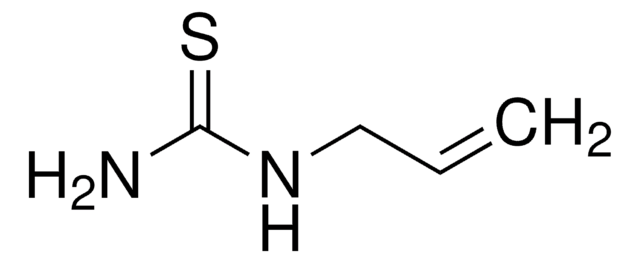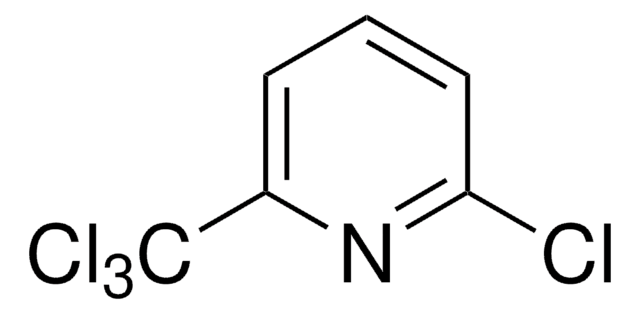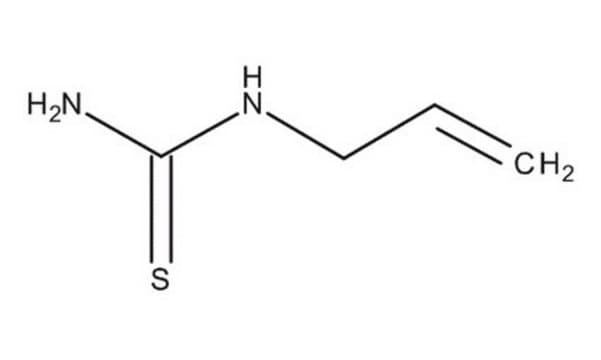C1930
2-Chloro-6-(trichloromethyl)pyridine
≥98%
Synonim(y):
Nitrapyrin, 2-Chloro-6-(trichloromethyl)pyridine, CP
About This Item
Polecane produkty
agency
suitable for SM 5210
Próba
≥98%
Postać
powder
rozpuszczalność
ethanol: 10 mg/mL, clear, colorless to faintly yellow
ciąg SMILES
Clc1cccc(n1)C(Cl)(Cl)Cl
InChI
1S/C6H3Cl4N/c7-5-3-1-2-4(11-5)6(8,9)10/h1-3H
Klucz InChI
DCUJJWWUNKIJPH-UHFFFAOYSA-N
Szukasz podobnych produktów? Odwiedź Przewodnik dotyczący porównywania produktów
Powiązane kategorie
Opis ogólny
Zastosowanie
- Biological and chemical nitrification inhibitors exhibited different effects on soil gross N nitrification rate and N(2)O production: a (15)N microcosm study.: This study examines the effects of biological and chemical nitrification inhibitors, including 2-Chloro-6-(trichloromethyl)pyridine, on soil nitrogen processes. The findings highlight the differential impacts on soil nitrogen dynamics and greenhouse gas emissions (Lan et al., 2023).
- Nitrous oxide emissions from manured soils as a function of various nitrification inhibitor rates and soil moisture contents.: This paper explores the relationship between nitrification inhibitor application rates, including 2-Chloro-6-(trichloromethyl)pyridine, and soil moisture on nitrous oxide emissions, providing insights into optimizing inhibitor use for environmental benefits (Lin and Hernandez-Ramirez, 2020).
- Nitrate losses in subsurface drainage from a corn-soybean rotation as affected by fall and spring application of nitrogen and nitrapyrin.: Investigating the seasonal application of nitrapyrin, a derivative of 2-Chloro-6-(trichloromethyl)pyridine, this study assesses its efficacy in reducing nitrate leaching and improving nitrogen use efficiency in agricultural systems (Randall and Vetsch, 2005).
- Oxidation of Nitrapyrin to 6-Chloropicolinic Acid by the Ammonia-Oxidizing Bacterium Nitrosomonas europaea.: This foundational research elucidates the microbial degradation pathway of nitrapyrin, contributing to our understanding of its environmental fate and persistence (Vannelli and Hooper, 1992).
Hasło ostrzegawcze
Danger
Zwroty wskazujące rodzaj zagrożenia
Zwroty wskazujące środki ostrożności
Klasyfikacja zagrożeń
Acute Tox. 3 Dermal - Acute Tox. 4 Oral - Aquatic Chronic 2
Kod klasy składowania
6.1C - Combustible acute toxic Cat.3 / toxic compounds or compounds which causing chronic effects
Klasa zagrożenia wodnego (WGK)
WGK 2
Temperatura zapłonu (°F)
212.0 °F - closed cup
Temperatura zapłonu (°C)
100 °C - closed cup
Środki ochrony indywidualnej
dust mask type N95 (US), Eyeshields, Faceshields, Gloves
Certyfikaty analizy (CoA)
Poszukaj Certyfikaty analizy (CoA), wpisując numer partii/serii produktów. Numery serii i partii można znaleźć na etykiecie produktu po słowach „seria” lub „partia”.
Masz już ten produkt?
Dokumenty związane z niedawno zakupionymi produktami zostały zamieszczone w Bibliotece dokumentów.
Klienci oglądali również te produkty
Powiązane treści
This page is intended to make it easier to find the consumables you need based on the analytical method you’re using. Methods included on this page come from the EPA, Standard Methods and ASTM.
Nasz zespół naukowców ma doświadczenie we wszystkich obszarach badań, w tym w naukach przyrodniczych, materiałoznawstwie, syntezie chemicznej, chromatografii, analityce i wielu innych dziedzinach.
Skontaktuj się z zespołem ds. pomocy technicznej













